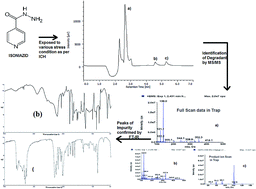Development of a green method for separation and identification of the degradation impurity of isoniazid by SFC-MS/MS
Abstract
To produce an eco-friendly stability indicating method, the reaction solutions containing degradation products of isoniazid were used for separation and optimized by varying the supercritical fluid chromatography (SFC) conditions. A mixture of supercritical carbon dioxide (SC-CO2) (85%) and modifier dichloromethane : methanol : ethyl acetate : formic acid (70 : 30 : 0.5 : 0.1 v/v/v/v) (15%) was used as a mobile phase and separation was achieved using a C-18 column. The degradation products separated at relative retention times (RRT) of 1.58 and 1.82, respectively. The method was validated as per international standards in terms of selectivity, linearity, precision and recovery. The drug shows a linear response at concentrations between 1 and 100 μg ml−1. The mean values (±%RSD) of the slope, intercept and correlation coefficient were 179 009 (±0.3%), 151 382 (±0.6%), and 0.9985 (±0.04), respectively. The mean %RSD values for intra- and inter-day precision were 0.63 and 1.29, respectively. The recovery of the drug ranged between 98.82 and 100.68%, when it was spiked into a mixture of solutions in which sufficient degradation was observed. The study was extended to SFC-MS/MS and FT-IR which were carried out to identify the degradation products. The FT-IR spectra and m/z values of the peaks at RRT 1.58 and RRT 1.82 matched with isonicotinic acid and isonicotinamide, respectively.


 Please wait while we load your content...
Please wait while we load your content...